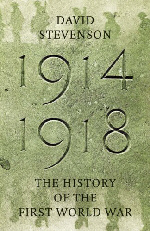Fourth Anniversary Issue
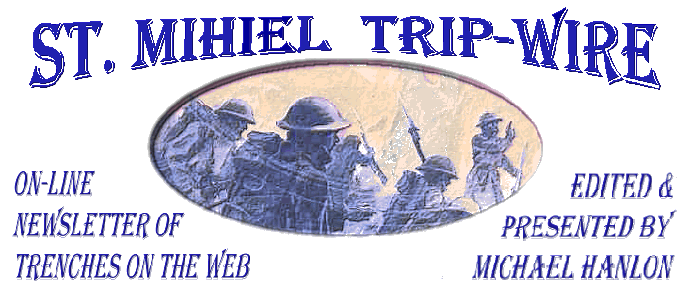
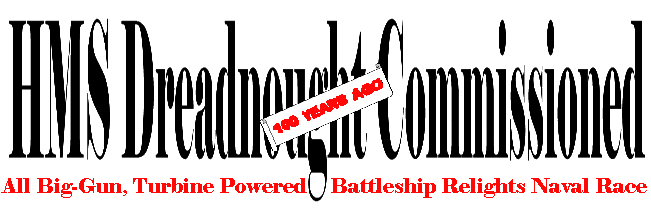
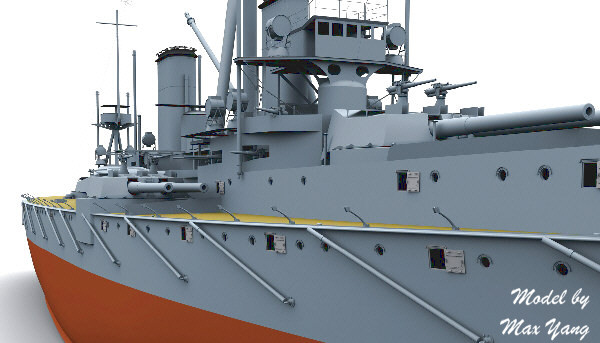
TRENCH REPORT: First let me offer a big Thank You to all the Trip-Wire's readers, supporters and contributors on our Fourth Anniversary. . .But Next, Let me talk about the future. I've had many requests to produce a Trip-Wire that people can download and print out. However, the flaw in that idea is that when you print out the Trip-Wire you lose all the hyperlinks. So I've come up with another approach to respond to this demand. As an experiment, this month's Special Supplement on the 100th Anniversary of the launching of the HMS Dreadnought is also available to download for Free as an Adobe Acrobat file. If you are interested in receiving hard copies of a second monthly publication in this format, please give this a try. Let me know what you think and whether you would be willing to pay $2.50 per issue for downloading it to cover our costs. This experimental document is five pages, the subscription version would be eight high quality pages. If you do not have the free Adobe Acrobat Reader on your computer, you will need to download it and I've provided an icon for you to do so. . .The reconstructed Vimy Ridge memorial will be rededicated on Sunday, April 8, 2007 (Easter Sunday). Queen Elizabeth and President Jacques Chirac are expected to attend. . .The Great War Society has announced that they have rescheduled their next National Seminar for Spring 2008.
MH
This Month's Internet Feature
Sgt. York
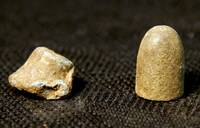
Two slugs believed to be from Sgt. Alvin York’s Colt .45 were found last month by Lt. Col. Doug Mastriano's Team
Doug Mastriano's Search for Alvin York
Michael Birdwell's York Biography
Sgt. York Photo Album
Alvin York's Diary
Sgt. York: The Movie
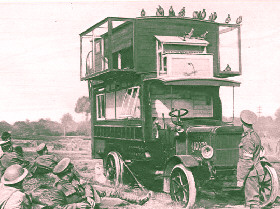
Pigeon Transporter
Western Front
New at the Websites of the Great War Society and Our Friends
Click on Title to Access
|
At Great War Society Sites
At the WFA-USA
|

Sole Surviving Tree, Delville Wood, Somme Sector
Captured by South African Brigade, 1916 (article)

The term "ace" was first used in World War I when French newspapers described Adolphe Pègoud as l'as (French for ace) after he shot down five German aircraft. He was also the first aviator to fly a loop and to jump with a parachute. He was shot down and killed August 31, 1915.
|
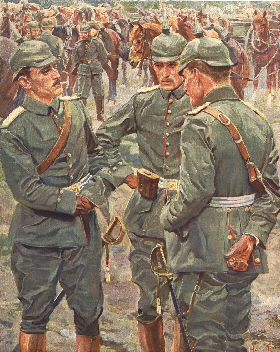
Cover from Early War Magazine Cover
Meggendorfer Blätter
GREAT WAR 2006 EVENT CALENDAR
|
Verdun and Somme
90th Commemorative Events
Comprehensive Double Calendar
Scheduled Throughout 2006 (link)
|
WFA-USA East Coast Chapter Seminar
Maryland War Memorial
November 4th
(Program)
|
WFA-USA New York/New England Chapter Seminar
Hartford, Connecticut
November 11th
(Program)
|
Armistice Day and the Great War Society
Great War Poster Artists and Luncheons With our Friends Jean- Pierre & Cecile Mouraux
Sonoma, California, November 11th
(details)
|
Reopening of Liberty Memorial & National WWI Museum
New spaces housing more than 49,000 artifacts, research center and archives.
Kansas City, MO; December 2nd
(details)
|
Send additions/corrections:
Email Response
|

Memorable Event
|
Emperor Franz Josef Dies

Sixty-Six Year Reign Ends
November 21, 1916
Click on Image for More Information
|
|
Author Dave Homsher's Enter the Yanks: the Battle of Château-Thierry has won the Best Book of 2006 award, History: Military Category, from USABookNews.com David has just repriced his book at $29.95 (link)
The 1917 British film the Battle of the Somme is being remastered and will be available on DVD later this year. (link)
Our Friends in the League of World War I Aviation Historians have their own take on Flyboys. Check it out. (link)
Avril Williams requests the pleasure of your company at the book launch for The Canal Bridge by GWS Member Tom Phelan in Ocean Villas Tea Rooms, 10 Rue Delattre, Auchonvillers Somme on Saturday, 4th November 2006.
WFA and GWS Member Werner Gruhl's new book Imperial Japan's World War Two, 1931-1945 will be published on December 30th and can be purchased now at: Amazon.com
Zeppelinologist Ray Remill has two new books out: Zeppelin and The Last Flight of the L-48. Take a look: (link)

From the Father of Dreadnought[s]:
Like the planet Neptune, the discovery of the dreadnought was inevitable, but luckily we saw her in the heavens before the other chaps and got our unparalleled lead! Thank God!
Admiral Jackie Fisher, 1910
|
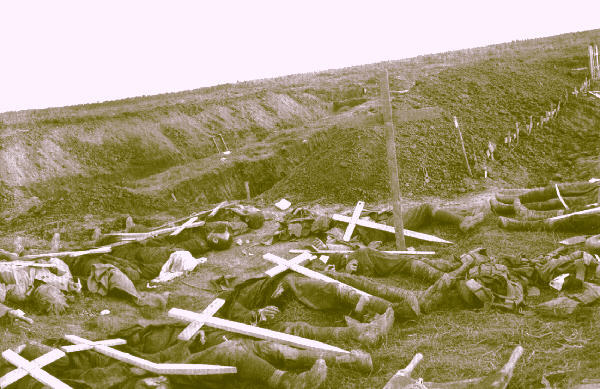
Faces Covered, American Dead of 27th Division Await Burial
Guillemont Farm, Somme Sector, Fall 1918
|
|
Page Two
|
World War I Aviation Historian Peter Grosz, who belonged to several of our organizations and spoke at numerous seminars and meetings passed away at age 80 in September. He was also the son of the renowned German Expressionist George Grosz and worked tirelessly to preserve his father's artistic heritage.
Harold Ford Gardner, 108, of Choconut, Pennsylvania, died Monday October 16th of complications from pneumonia. As a draftee he served exactly one day in the US Army, November 11, 1918. Sent home after a few hours, he later received a full discharge and a check of $1 for his war service.
|
Eton At Verdun?
By Christina Holstein
Schools in England, as in other countries, are divided into 'public' and 'private'. That might seem logical but in England things are not so straightforward. For reasons lost in the mists of time the schools known as 'public schools' are in fact private. The name refers to a number of old-established, high-level boarding schools, of which the most prestigious is Eton College, Windsor, in Berkshire. Founded by King Henry VI in 1440, Eton College has educated some of the most famous men in British history and numbers among its most recent pupils Princes William and Harry of Wales.
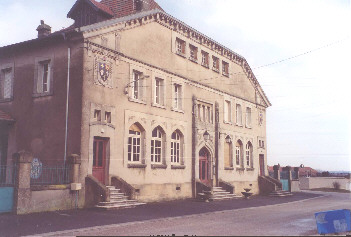
Eton's Mairie
I don't know how many places in the world have the name Eton but one of them lies on my route from Luxembourg to Verdun. It is a small village some 30 kilometres to the north of Verdun and from it Fort Souville, the second-highest fort on the Right Bank of the River Meuse at Verdun, which was described by General Petain as 'the last bolt on the door to Verdun', can be seen. The village was completely rebuilt after WWI. A number of the houses have interesting architectural features, such as small towers like lookout posts set high up on the building, and if you wander round the back streets you come to the mairie, or town hall, which bears two large coloured coats of arms proudly proclaiming that the mairie of this little Meuse village was the gift of Eton College, England.
Being intrigued by this, we recently sent photos to the College and asked if they had any information. The archivist, Mrs P. Hatfield, replied that in about 1921 the Mayor of Eton wrote to 'Le Lord Maire d'Eton, Angleterre" appealing for assistance for his commune which had been devastated by the war. The letter was opened by a former Eton Master, who at that time was a Member of Parliament. He got in touch with the British League of Help and, for a start, some gifts in kind were sent over with about £50 in cash, collected in the school, for immediate help.
The formal adoption of Eton by the College and School followed and, following a report from an Old Etonian who visited the village and interviewed the Mayor and other officials, it was decided to rebuild the village school and mairie, which were housed in the same building. An appeal to Old Etonians all over the world for a sum which would be sufficient to carry out the work in a worthy manner brought in £1200, which was a gratifying result. A deputation of subscribers went to Verdun in April 1926 to assist at the solemn inauguration of the school and mairie The Mayor had arranged an interesting programme for his guests and promised them a pleasing surprise but unfortunately neither the Eton College Chronicle nor the present archivist can cast any light on what that might have been.
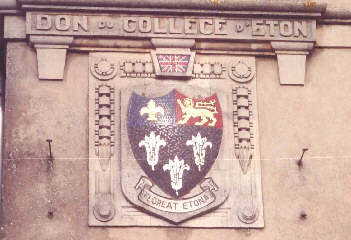
Eton's Crest on the Mairie
The little villages in the old German rear to the north of Verdun offer frequent surprises to visitors. Far to the north, where the villages were not damaged, buildings used by the Germans can appear exactly as they are on old German postcards. The rebuilt villages, on the other hand, rarely have interesting features. The massive mairie at Eton, with its gilded coat of arms, Union Jack, and Latin inscription, is unusual in that respect and the villagers were no doubt extremely pleased to have so surprising a building and such august connections.
|

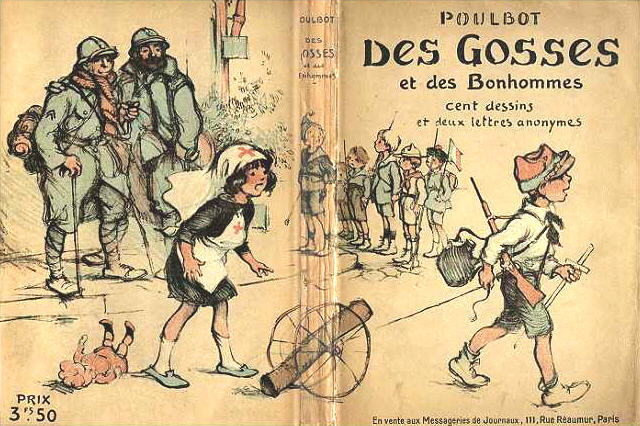
Book Cover by French Children's Artist Fransique Poulbot
Click Here to Visit War in a Different Light
|

|
The President Will Now Place a Wreath on the Cenotaph
From Tom Phelan, GWS Member
|
The only thing warm in the Irish National War Memorial in Islandbridge on July 1 was the brilliant sunshine. The only things bright and beautiful were the circular tiers of roses in full bloom in the two sunken gardens. The only spontaneity was in the songs of the birds.
In front of the cenotaph there was a cordoned area for VIPs whose identities?except for the lord mayor of Dublin, the taoiseach and the president?were not revealed. Programs were set out on each VIP's chair, but there were none for the general public.
Seamus Heaney was not there with an elegy. There was no uilleann piper to wail one of our own haunting Irish laments. There were no orators to stir the heart, no historians to tell stories of heroes. There were no dancing great-grandchildren in swirls of color and lightning steps to celebrate the men who gave them life. There were no tenors to wring the ninety-year-old grief out of the memorial stones. And, of course, there were no poppies. God forbid there should have been poppies?the Irish republican sky would have fallen.
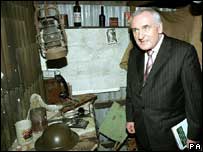
Mr. Ahern at the Event |
Ireland's first "official" commemoration of the Battle of the Somme--the first official remembrance of anything related to World War One--was not a commemoration of the 35,000 Irishmen who died in Europe and Gallipoli. Instead, it was a cold, reluctant, rubrical performance in which the only words spoken by a dignitary--Taoiseach Bertie Ahern--were: "The president will now lay a wreath at the cenotaph." Even President Mary MacAleese's inspection of the honor guard was held outside the Gardens--inside, the armed forces were represented only by its band and perhaps two dozen cadets. Who needs dignitaries at a commemoration if not one of them has the gumption to stand up and at least say why everyone is gathered in this one spot? But who can blame them for remaining silent? Their very being is based on an unsupportable myth that would completely collapse if they were to give praise to the Irish men and women who served and died in the First World War.
Many of the 220,000 Irishmen who signed up to fight in WWI did so to provide bread for their families?soldiering was a job when no other jobs were available. But many also went to war in response to John Redmond's assurance that they would be fighting for Ireland on foreign soil. Others went at the behest of the Catholic pulpit to save small Catholic Belgium. Many rushed to the colors out of patriotic duty, especially in the northern counties. There were some who joined the army for the adventure of the whole thing. Some from the south went in response to Redmond's hope that if they fought side by side with the soldiers from the north, their common experience would help them resolve their differences in a peaceful manner when the war was over.
It is not possible to truly commemorate Ireland's WWI soldiers without first facing up to the reality, or unreality, that was Padraig Pearse. Pearse, obsessed with carving out his own personal niche in the pantheon of Irish heroes, was determined to spill his blood for Ireland. So incessant was his talk about the need for blood sacrifice that James Connolly once called Pearse "a blithering idiot."
In 1916, with two years of the European war gone by and the likelihood of the ending of hostilities getting closer by the day, Pearse's opportunity to sacrifice himself was slipping by. He knew that the Home Rule Bill, passed in the House of Commons in 1914, was due to be implemented with the restoration of peace in Europe. Despite the fact that nationalist Ireland had rejoiced at the passage of the bill, Pearse was determined to daub his blood on Ireland's history books.
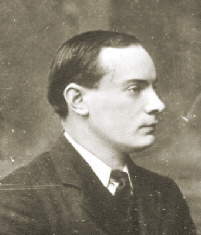
Padraig Pearse |
In his proclamation of independence, Pearse announced that his rebellion had the support of "our gallant allies in Europe." What was he thinking when he claimed this support of the Germans? Surely he couldn't have been thinking about his 220,000 fellow Irishmen fighting against Germany in the trenches. What did he hope to gain by rebellion that had not already been achieved by the Irish Parliamentary Party in London? And if the man was at all serious about achieving Ireland's freedom with force of arms, why did he barricade himself in a building and wait for a well-trained, well-equipped army to come and get him? In modern terminology, he set up a "suicide by cop" scenario. In the end, Pearse's rising won nothing more than was already guaranteed by the Home Rule Bill.
In his rush to stand alongside the mythic Cú Chulainn, the patriotic Pearse didn't care that he was betraying those 220,000 Irishmen. He didn't consider the likelihood that many civilians would be killed on Dublin's streets. He didn't care that central Dublin would be reduced to rubble. And as he kept his eye on his self-immolating ambition, he didn't care that the soldiers in the British army opposing him would be Irishmen. Of course he could not have foreseen that his rebellion would lead to the grandiloquent and unnecessary War of Independence, to the introduction of the Black and Tans, and to the Civil War.
Padraig Pearse stole the flag from Parnell and Redmond and the Irish soldiers of WWI. He selfishly wrapped himself in it, and those who are in need of the myth of Pearse have succeeded in keeping it securely sewn around him. Pearse's betrayal of Ireland's fighting men was continued when the survivors came home from Europe?they were not-so-subtly banished to the sidelines of Irish life, some even murdered. In the end it was not Pearse who effected anything for himself; it was General Maxwell's ill-advised bullet in his heart that raised Pearse to instant and undeserved patriotic canonization. Now that the emotional response to Pearse's execution has faded it is easier to see that the emperor has no clothes?just as the citizens of Dublin knew during the rebellion and before the executions took place.
In 1927 it was proposed that a memorial to Ireland's WWI dead be built in Merrion Square adjacent to the parliament building-Leinster House. Speaking for the Cosgrove government, Kevin Higgins, T.D., said, "To devote Merrion Square to this purpose would be to give a wrong twist, as it were, a wrong suggestion to the origins of this state... No one denies the sacrifice, and no one denies the patriotic motives which induced the vast majority of those men to join the British Army to take part in the Great War, and yet it is not on their sacrifice that this state is based, and I have no desire to see it suggested that it is." Of course, Higgins did not need to say on whose sacrifice he believed the state was based--the emotion surrounding the shooting of the fifteen 1916 rebels was still thick in the air.
About the author:
Tom Phelan is the author most recently of The Canal Bridge, a novel of Irishmen in the First World War, published by the Lilliput Press of Dublin and distributed in the United States by Irish Books and Media and by Dufour Editions. and distributed in the United States by Irish Books and Media and by Dufour Editions.
|
|
Page Three
|
Verdun
November 1916:
Focus on the
Forts |

|
The Somme
November 1916:
The End!
|
At the end of October, Douaumont had been recaptured.
The next day French engineers examined the fort. They found there was much damage which, although serious and extensive, was largely superficial. The hammering it had undergone for months had not reduced it to rubble and the engineers considered that repair work could proceed with immediate effect.
The worst aspect was clearing up the human refuse. The Germans had put in place a "Fort Commandant" whose terrible job was to put and keep discipline and organization into the huge rambling structure, through which came and went some 1-2000 men every day, to keep control of food, ammunition, water supplies (all of which had to be brought into the fort by the men), to evacuate the wounded and dispose of the dead. Constant and deadly shelling made access into and out of the fort very difficult and every man took his chance entering and leaving. Those whose luck ran out could not be buried and their remains littered the area.
Cess pits were full to overflowing. Those who had died in the fort had been buried in quicklime, walled up in disused rooms and now had to be unearthed in their disintegrating state. Absolute general filth abounded. Internal access was difficult, since many passages were blocked by fallen masonry and some of the underground passages were flooded. It was said you could smell the fort a mile away!
Volunteers were called for to clear up this huge rubbish heap???.one wonders how many men "volunteered"?
Fort Vaux fell on November 2nd after the Germans had abandoned it, blowing up the 75mm turret in the process and causing a lot of the damage that can still be seen today. The fort was found to be in an equivalent state to Ft.Douaumont and, again, repair work was instructed. Both forts had extra fortifications added into the ruins. The town of Verdun was nearly safe.
|
The filthy, foul, cesspit of the battlefield became impossible for men to live in.
But they did, on both sides.
And still the battle wore on; more slowly now, since movement was almost impossible.
There were a few last attempts to move the line forward, but now winter was in charge and finally, the appalling physical circumstances forced a halt on the battle.
It faded away.
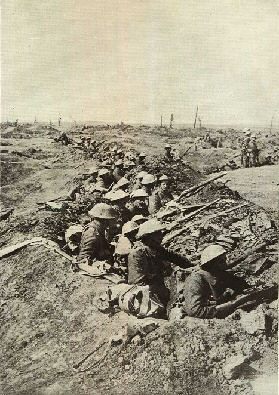
The Somme - Late Stage
The men who survived it and who now garrisoned the wasteland, lived in the mud through the winter.
During the winter, Hindenburg and Ludendorff instructed the building of the Hindenburg Line away to the East. This masterpiece of defensive construction shortened the German lines, allowed them to free some of their battered units for a very much needed refit, to bring others from the Eastern Front, and gave them a new front line against which they believed the BEF would expend itself in useless effort in 1917.
|
|
If you are travelling to Europe and would like to visit these fields of memory for a detailed tour, please contact experienced guides Tony Noyes or Christina Holstein at Back to the Front
|
|
 |
Why I Write About
The First World War
Historian David L. Stevenson
|
As to how I got interested in the subject in the first place… well, when growing up in the Midlands and in London suburbia in the 1960s I was very conscious that my father’s and my grandfathers’ generations had fought in two world wars, and that my own might be engulfed in a third. But up to the age of about fourteen it was images of 1939-45 rather than 1914-18 that – through newsreel footage, television, books, and comic strips – dominated my understanding of what wars were like. When I first borrowed a history of the Great War from the public library and realized that the Western Front got stalemated after the opening round of fighting and moved very little until the last few weeks, I can still remember my reaction: ‘Was that all that happened?’.
Two influences changed that view (both of them rightly stressed in recent studies that have underlined how the 1960s marked a turning point in British perceptions of the war). One was A. J. P. Taylor’s The First World War: an Illustrated History, which is still, I am delighted to see, a fixture on Penguin’s history list, and still published in a format identical to the inimitable original. My father bought me a copy when I was in hospital with a broken leg, which gave me the enforced leisure needed to read it. Taylor’s trenchant prose and his disabused world-view were revelations: as was his implication that what had happened before could happen again, and the next time with nuclear weapons. The second influence was the marathon twenty-six-episode BBC television series on The Great War, which I watched on its repeat showing. John Terraine’s and Correlli Barnett’s scripts, the elegaic mood music, and Michael Redgrave’s sombre narration created such memorable juxtapositions of words and atmosphere that many of them remained familiar when I next viewed the programmes more than thirty years later.
Taylor and the BBC endowed the war with an intellectual and imaginative fascination that has never lost its grip. That fascination led on to me writing a doctoral thesis and five books. It also heightened my awareness of the living connection with the conflict through my mother’s father, John Howard Davies, who volunteered in 1914 and served in the Royal Welch Fusiliers and the South Wales Borderers. He became an officer and was twice wounded. He was a man of quiet dignity whom I greatly respected: his wife Enid, to whom he became engaged before his active service and whom he married after it, had equally painful recollections from the period, including of a false alarm that her fiancé was reported missing. I assume it is no accident that other recent writers on the war, such as Ian Beckett, Niall Ferguson, and Hew Strachan, also refer to grandfathers who fought in it. Personal memory – even at one remove – still lends the subject an immediacy and a self-evident importance that more distant historical events seem no longer to possess.
Professor Stevenson's WWI History 1914-1918 is available at Amazon.com
|
|
World War I Headlines
in the
21st Century
|
|
 |
Flyboys Revisited
By Andrew Melomet
|
I received email after last month's column on Flyboys, tasking me for my mostly positive review. I guess if Flyboys was titled "The True Story of the Lafayette Escadrille" I would have written a negative review. But, Flyboys does not set itself up as the true story of the Lafayette Escadrille. The title Flyboys is both whimsical and slightly derisive indicating to me that this is not a movie deeply concerned with more than a whiff of reality. And that's okay by me. After all, a movie is primarily just entertainment. Anything more is often secondary. Movies are both a visual art form and show business; and this inherent dichotomy allows for both filmmaking art and box office.
As part of the nearly lost aviation genre of movies, Flyboys deals out the lyricism of flight, heroism and honor and sudden death in the air, and the tension and fatalism of combat and lost comrades. Flyboys is both a throwback and homage to that lost genre. When you consider the aviation genre films dealing with World War One, these major themes (and others) run through them all.
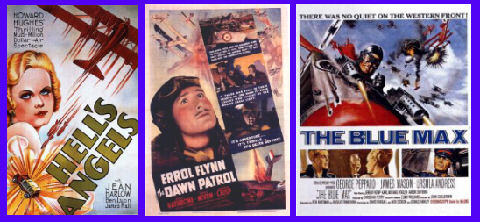
Here's a partial chronological list of the major Great War aviation films. I've selected titles that have been officially released on VHS, laserdisc and DVD and those that can also be found on eBay in various formats. I've also included titles that air on Turner Classic Movies.
- The Girl Who Stayed At Home, D.W. Griffith, 1919
- Wings, William Wellman, 1927
- Lilac Time, George Fitzmaurice, 1928
- The Dawn Patrol (Flight Commander), Howard Hawks, 1930
- Hell's Angels, Howard Hughes 1930
- The Last Flight, William Dieterlie 1931
- Sky Devils, Edward Sutherland 1931
- The Lost Squadron, George Archainbaud 1932
- Ace of Aces, J. Walter Ruben 1933
- The Eagle and the Hawk, Stuart Walker 1933
- Today We Live, Howard Hawks 1933
- The White Sister, Victor Fleming, 1933
- Crimson Romance, David Howard, 1934
- Hell in the Heavens, John Blystone, 1934
- Suzy, George Fitzmaurice, 1936
- The Dawn Patrol, Edmund Goulding, 1938
- Men With Wings, William Wellman, 1938
- The Court-Martial of Billy Mitchell, Otto Preminger, 1955
- Lafayette Escadrille, William Wellman, 1957
- The Blue Max, John Guillerman, 1966
- Darling Lili, Blake Edwards, 1969
- Von Richthofen and Brown, Roger Corman, 1971
- Zeppelin, Etienne Perier, 1971
- Ace Eli and Rodger of the Skies, John Erman, 1973
- Aces High, Jack Gold, 1976
- The Great Waldo Pepper, George Roy Hill, 1976
As it happens, Flyboys did not do great box office here in the United States, grossing about $6 million. It might do better internationally. For those who missed it in the theaters, it's scheduled to be released on DVD in January 2007.
Andrew Melomet, Proprietor of Andy's Nickelodeon will answer your Great War film or video inquiry. He is also soliciting your recommendations for the WWI Filmography he is compiling for our readers. Just click HERE.
|
|
|
Special Anniversary Supplement
|
| This supplement can be downloaded independently of the Trip-Wire as an Adobe Acrobat PDF File so you can view it or print it out as a separate document. There will be no charge for this. |

You need to have the free Acrobat Reader if you do not have it on your computer. Click on the icon to download it |

Click here to download our Special Anniversary Supplement. |
| If you download this pdf file, please contact me and tell me if you would consider subscribing to a monthly series of 8-page features like this one. (greatwar@earthlink.net) |
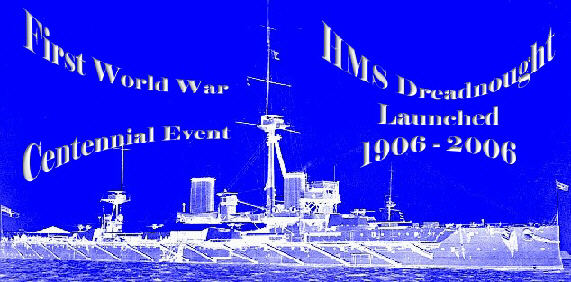
The Dreadnought CentennialStephen McLaughlin
This year marks the centenary of the launch of HMS Dreadnought, brainchild of Admiral Sir John Fisher and the ship whose name soon became synonymous with a new breed of battleships. Soon all the major naval powers - and some minor ones, too - were building or buying dreadnoughts, and the dreadnought race between Britain and Germany contributed to the growing tensions between these two nations.
So what was it about Dreadnought that was so different? It wasn't her turbine engines; although these were considered a daring technical leap forward, several ships considered dreadnoughts would be powered by the older style reciprocating engines. Nor was it her armor protection, which was actually slightly inferior to that of her immediate predecessors, the Lord Nelson class. The one thing that set Dreadnought apart was her battery of ten 12-inch guns, of which eight could be fired on either broadside. Previous battleships had featured a battery of four 12-inch guns supplemented by a number of smaller guns -- anything from 7-inch to 10-inch in caliber.
|
HMS Dreadnought (1906)
- Period in service: 1906 - 1918
- Displacement: 18,110 tons
- Length: 160.6m / 527ft
- Beam: 25m / 82ft
- Complement: 773
- Speed: 21kts
- Armament: 10 x 12 inch (305mm) guns; 27 x 12 pounder guns; 5 x 18 inch (457mm) torpedo tubes
- Armour: 4 - 11 inch belt; 4 inch deck; 4 - 11 inch barbettes; 11 inch turrets
|
As gunnery ranges grew longer, it became difficult to control these mixed batteries, since the guns differed in ballistic performance; moreover, it was hard for the officers controlling gunfire to distinguish the splash of, say, a 9.2-inch shell from a 12-inch shell, so making corrections could became confusing.Continued below.
|
|
Dreadnought Centennial cont.
Thus HMS Dreadnought was the first battleship that could really take advantage of the long-range capabilities of her big guns, something that was important not only because it gave her the possibility of hitting an enemy before she could be hit in return, but also because it meant she could fight outside the range of torpedoes. Advances in propulsion had dramatically increased the effective range of torpedoes from less than a thousand yards at the turn of the century to about 3,000 yards or more by the time Dreadnought was laid down; by 1914, the British and German fleets would be equipped with torpedoes that had 10,000-yard ranges.
Although Dreadnought did not initiate the naval race between Britain and Germany, it did intensify matters. First, by making all previous battleships obsolete it wiped out Britain's existing lead in capital ships - both nations were starting the new battleship race from scratch.
Perhaps even more significantly, Dreadnought initiated a race in which each nation sought to build ever-larger battleships.
|
Dreadnought herself had displaced 18,120 tons and cost about £1.8 million, whereas the "R" class battleships of 1913 with larger 15-inch guns and heavier armor displaced 30,400 tons and cost £2.5 million. German battleships showed a similar increase in size and cost.
Both nations found the enormous cost of the naval race increasingly difficult to bear; but Britain had two key advantages - her shipyards could build ships more cheaply, and she didn't have to maintain a massive standing army.
By 1914 Germany was clearly losing the race - five "R" class battleships were laid down under the British 1913 program, whereas the corresponding German program included only two battleships and one battlecruiser.
Mention of battlecruisers raises another aspect of Fisher's building policies, the large, fast, weakly armored super-cruisers - but that's a story for another time. Today it is enough to remember HMS Dreadnought and her descendents, the big battleships that dominated naval and even national policies for more than three decades.
|
HMS Dreadnought at War
When the great struggle finally came Dreadnought was a bit "long in the tooth." Serving in the Third Battle Squadron of the home fleet for most of the war, the ship did accomplish a singular feat of arms. On March 18, 1915 she rammed and sank U-29 [below] in the North Sea. HMS Dreadnought thus holds the distinction of being the only battleship to sink a submarine in combat.
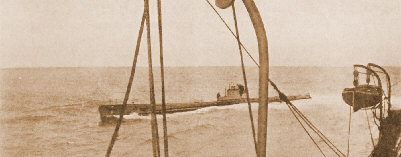
|
Shadow Over Dreadnought[s]Paul Kennedy
[In addition to Jutland] there was another epic First World War naval battle that should have cast more doubt upon the long-term future of the large-gunned warship. It was that initial attempt to force the Dardanelles on March 18th, 1915 by an Anglo-French battlefleet alone, with disastrous results. A rather modest row of mines laid by the diminutive Turkish minelayer Nousret inflicted more damage to Allied seapower than any other single measure; three battleships (the Ocean and Irresistable, and the French battleship Bouvet) were sunk and the battlecruiser Inflexible badly damaged. Meanwhile, Turkish coastal artillery severely wounded one French battleship and caused another to be beached. Thus, six heavy ships had been put out of action in one encounter. . .Even more to the point is the uncomfortable fact that the severe damage inflicted, especially at the Dardanelles, pointed to the Dreadnought's vulnerabilities right at the presumed zenith of its power and influence. It is an irony worth exploring.
Students of the history of military technology so often point out that every great "leap forward" in weapons systems will sooner or later provoke others to devise alternative systems which thus readjust the balances - the balances between big and small, and between offensive and defensive warfare. This is surely true. The bomber did not always "get through", and German Blitzkrieg warfare died in the western outskirts of Moscow in late 1941.
Yet it is worth arguing that there was something special about the military-technology scene in the Edwardian era because there was being developed not merely one, but at least five new weapons that affected control of the sea. The first was, of course, the all-big-gun ship. But consider also another four:
|
(a) The Naval Mine - a sneaky, invisible, defensive weapon to be sure, but one that denied battlefleets the freedom to steam where they wished. . .
(b) Then there was the torpedo, which was already being developed years before the Dreadnought was launched. The point about this weapon was not its increasing speed, range, and explosive force, although those features were frightening enough. It was, rather, the awful fact that it could be launched against heavy warships from multiple platforms - torpedo-boats, destroyers, submarines, and aircraft, rather like today's cruise-missiles. . .
(c) The submarine itself offered, surely, a military revolution even greater than that produced by the Dreadnought.. .It was not surprising that during the postwar Washington naval limitations talks the British sought to get the submarine abolished altogether!. . .
(d) The fourth military-technological innovation to challenge the dominance of the Dreadnought was the coming of the airplane. . .It is simply worth noting that the air challenge came in two forms, and in separate but related questions: first, would the new carriers replace the battleship as the queen of the sea; and, secondly, had warships become too vulnerable to aerial attack to be viable in future wars?. . .
In describing [the 1945 sinking of the Japanese Super-Dreadnought Yamato by American carrier aircraft], the great American naval historian Samuel Eliot Morison commented, "When she went down, five centuries of naval warfare ended". Morison's reference, clearly, went all the way back to those early years of the long-range, gun-carrying vessels of the late-fifteenth and early-sixteenth centuries. But the same could be said, even more emphatically, of the Dreadnought era.
|
|
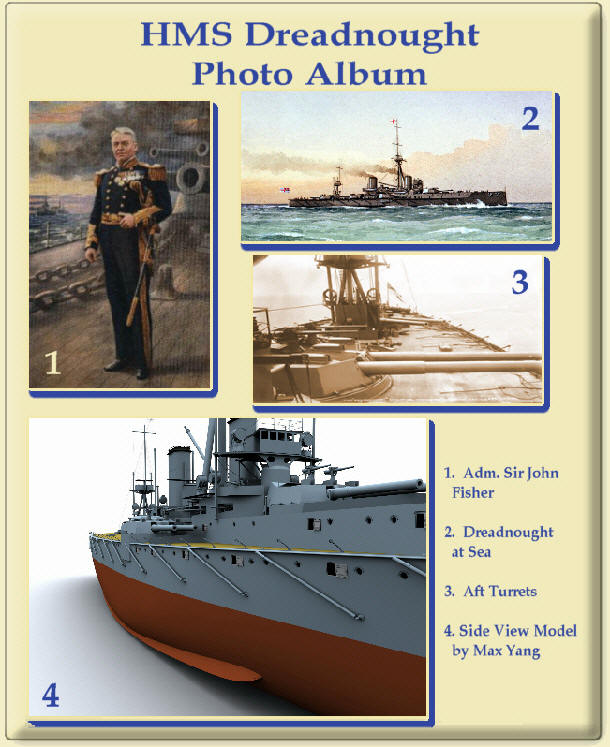 This Special Supplement was conceived by Editor Michael Hanlon and produced with the great help of our contributors including: Battleship authority Steve McLaughlin whose latest work Russian and Soviet Battleships is available at
Amazon.com; Professor Paul Kennedy of Yale University whose selection is from his 2006 presentation, HMS Dreadnought and the Tides of History; Max Yang and Tony Lovell of the Dreadnoughtproject.org contributed the model photo; Tony Langley helped with photos and Kimball Worcester with editing; and the websites of the US Navy and Royal Navy were drawn upon for illustrations and details. Presented originally with the November 2006 St. Mihiel Trip-Wire.
This Special Supplement was conceived by Editor Michael Hanlon and produced with the great help of our contributors including: Battleship authority Steve McLaughlin whose latest work Russian and Soviet Battleships is available at
Amazon.com; Professor Paul Kennedy of Yale University whose selection is from his 2006 presentation, HMS Dreadnought and the Tides of History; Max Yang and Tony Lovell of the Dreadnoughtproject.org contributed the model photo; Tony Langley helped with photos and Kimball Worcester with editing; and the websites of the US Navy and Royal Navy were drawn upon for illustrations and details. Presented originally with the November 2006 St. Mihiel Trip-Wire.
|
|
| The following are thanked for their contributions to this issue of the Trip Wire:Susan Neeson, Tom Phelan, Tony McIntosh, Tony Langley, Christina Holstein, Tony Noyes, Esther MacCallum-Stewart, Andy Melomet, Len Shurtleff. Old Fritz found this month's fact at the Aerodrome website. Professor Stevenson's comments are from the Penguin Books website. Contributors to the Special Supplement are listed therein. Until next month, your editor, Mike Hanlon. |
|



























